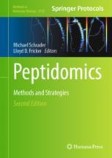Search
Search Results
-
Profiling Human Cerebrospinal Fluid (CSF) Endogenous Peptidome in Alzheimer’s Disease
Human cerebrospinal fluid (CSF) is a rich source for central nervous systemNervous systems (CNS)-related disease biomarker discovery due to its...
-

-
Integrating host transcriptomic signatures for distinguishing autoimmune encephalitis in cerebrospinal fluid by metagenomic sequencing
BackgroundThe early accurate diagnoses for autoimmune encephalitis (AE) and infectious encephalitis (IE) are essential since the treatments for them...

-
Cerebrospinal fluid neutral lipids predict progression from mild cognitive impairment to Alzheimer’s disease
Genetic, metabolic, and clinical evidence links lipid dysregulation to an increased risk of Alzheimer’s disease (AD). However, the role of lipids in...

-
Multiplex cerebrospinal fluid proteomics identifies biomarkers for diagnosis and prediction of Alzheimer’s disease
Recent expansion of proteomic coverage opens unparalleled avenues to unveil new biomarkers of Alzheimer’s disease (AD). Among 6,361 cerebrospinal...

-
Brain washing and neural health: role of age, sleep, and the cerebrospinal fluid melatonin rhythm
The brain lacks a classic lymphatic drainage system. How it is cleansed of damaged proteins, cellular debris, and molecular by-products has remained...

-
Association of postoperative delirium with serum and cerebrospinal fluid proteomic profiles: a prospective cohort study in older hip fracture patients
Postoperative delirium (POD) is a common neuropsychiatric complication in geriatric inpatients after hip fracture surgery and its occurrence is...

-

-

-
Cerebrospinal fluid proteomics in patients with Alzheimer’s disease reveals five molecular subtypes with distinct genetic risk profiles
Alzheimer’s disease (AD) is heterogenous at the molecular level. Understanding this heterogeneity is critical for AD drug development. Here we define...

-
Metagenomic data from cerebrospinal fluid permits tracing the origin and spread of Neisseria meningitidis CC4821 in China
Metagenomic next-generation sequencing (mNGS) is useful for difficult to cultivate pathogens. Here, we use cerebrospinal fluid mNGS to diagnose...

-
Clinical Characteristics, Treatment, and Outcomes of Veterans with Cerebrospinal Fluid Culture Positive for Gram-Negative Rod Bacteria: A Retrospective Analysis over 18 Years in 125 Veterans Health Administration Hospitals
Optimal management for patients with bacterial ventriculitis/meningitis due to Gram-negative rods (GNRs) has yet to be well investigated. We assessed...

-
Protein fibril length in cerebrospinal fluid is increased in Alzheimer’s disease
Alzheimer’s disease (AD) associated proteins exist in cerebrospinal fluid (CSF). This paper evidences that protein aggregate morphology distinctly...

-
Culture of cerebrospinal fluid-contacting neurons from neonatal mouse spinal cord
Cerebrospinal fluid-contacting neurons (CSF-cNs) act crucial role in chemosensory and mechanosensory function in spinal cord. Recently, CSF-cNs were...

-
Bacterial identification in cerebrospinal fluid of domestic species with neurologic signs: a retrospective case-series study in 136 animals (2005–2021)
Central nervous system (CNS) infections comprise life-threatening clinical conditions in domestic species, and are commonly related to severe...
-
Seed amplification assay for the detection of pathologic alpha-synuclein aggregates in cerebrospinal fluid
Misfolded alpha-synuclein (αSyn) aggregates are a hallmark event in Parkinson’s disease (PD) and other synucleinopathies. Recently, αSyn seed...

-
Cerebrospinal fluid camk2a levels at baseline predict long-term progression in multiple sclerosis
BackgroundMultiple sclerosis (MS) remains a highly unpredictable disease. Many hope that fluid biomarkers may contribute to better stratification of...

-
Rebound HIV-1 in cerebrospinal fluid after antiviral therapy interruption is mainly clonally amplified R5 T cell-tropic virus
HIV-1 persists as a latent reservoir in people receiving suppressive antiretroviral therapy (ART). When ART is interrupted (treatment...

-

